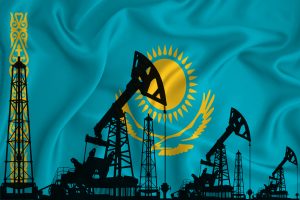Daily production at the Kashagan oil field has dropped by 60 percent, according to the Kazakh Ministry of Energy, amid planned maintenance work, contributing to a 13 percent decrease in production nationally.
Last month the ministry requested that the partners in the North Caspian Operating Company (NCOC) consortium that operates Kashagan delay scheduled maintenance work – which was slated to begin in October – into next year.
When the Kashagan field was discovered in 2000, it was the second largest known oil field in the world. Its recoverable reserves are estimated to be 9 to 13 billion barrels of oil. When consistent commercial production began in 2016, the project was dramatically behind scheduled and more than $30 billion over budget. (Production had actually started in 2013 but the field shut down within a month due to leaks in a pipeline.)
At present, the Kashagan field is managed by NCOC, in which a plethora of oil major subsidiaries are shareholders: KMG Kashagan B.V., a KazMunayGas subsidiary (16.877 percent), Shell Kazakhstan (16.807 percent), Total EP Kazakhstan (16.807 percent), AgipCaspian Sea B.V. (16.807 percent), ExxonMobil Kazakhstan (16.807 percent), CNPC Kazakhstan B.V. (8.333 percent), and Inpex North-Caspian Sea Ltd. (7.563 percent).
The Kashagan field is said to produce 400,000 barrels per day, typically.
Maintenance work at Kashagan was scheduled to begin on October 3, but commenced on October 7.
Minister of Energy Almasadam Satkaliyev said that repair work was expected to law between 30 and 40 days.
“The Ministry of Energy has approved the scheduled maintenance for a duration of 40 days; however, the consortium management (NCOC) has indicated their intention to complete the repairs in a shorter timeframe of 30 days,” he said
Despite Kazakhstan’s efforts to reschedule the Kashagan maintenance, the drop in production conveniently forces Astana to meet commitments it has made to OPEC+ to reduce oil production.
As Reuters reported last week, “Kazakhstan has been one of the laggards in the OPEC+ deal to curb oil production, persistently exceeding the group’s output quota.”
Production had increased in September, Reuters reported, “thanks to a 30% output boost at the Tengiz field” following the completion of maintenance work there.
The Tengiz oil field began production in 1993 and is believed to be the sixth largest oil field in the world. Tengiz is presently operated by Tengizchevroil with several stakeholders: Chevron Corporation (50 percent), ExxonMobil Kazakhstan (25 percent), KazMunayGas (20 percent), and Lukoil (5 percent).
Although Kashagan is technically the larger field, Tengiz outperforms it in production, with announced targets for 2023 around 608,000 barrels per day.
This is not the first time Kazakhstan has disappointed its OPEC+ partners with production overruns.
The maintenance work also comes as Astana looks to settle a dispute regarding a $5 billion environmental fine with the Kashagan partners. As Bloomberg reported last week, “Oil majors including Eni SpA, Shell Plc, Exxon Mobil Corp. and TotalEnergies SE have drafted proposals related to allegations they stored too much sulfur at the field.”
The root of the environmental fine is a 2022 inspection by the Atyrau Region’s Ministry of Ecology, which claimed to find that the field had far exceeded sulfur storage limits. According to Bloomberg’s reporting, the Kashagan partners are offering to make additional investments in social projects ($110 million over two years), found a million dollar social development fund, as well as make additional payments “related to the supply of liquefied petroleum gas to the government.”
The proposal, in turn, seeks the withdrawal of the “sulfur-damage compensation claims in Kazakhstan and all environmental damage claims in international arbitration” and changes to Kazakh law to avoid future claims. The partners would also not admit any fault in a prospective settlement.
In a separate case, Kazakhstan is pursuing a $160 billion claim against Eni SpA, Shell Plc, Exxon Mobil Corp., and TotalEnergies SE. That figure has balloon enormously since Kazakhstan’s government first requested $16.5 billion in June 2023 as compensation for disputes related to production and revenue sharing. Kazakhstan claims that revenue from production was never fully delivered to the government, despite promises.
Bloomberg’s sources tied the escalating claim to allegations of corruption.
Nearly a decade ago, Casey Michel wrote here at The Diplomat that Kashagan was Kazakhstan’s white whale” – “always in sight, but always just beyond reach.” Its white whale era may have passed, but it’s worth remembering what happened to Ahab in the end.
In 2020, Kazakhstan announced its intention to achieve “carbon neutrality” by 2060. Some analysts argue that target is ambitious but achievable. But for the time being, fossil fuels remain central to Kazakhstan’s economy and to its energy mix.
































